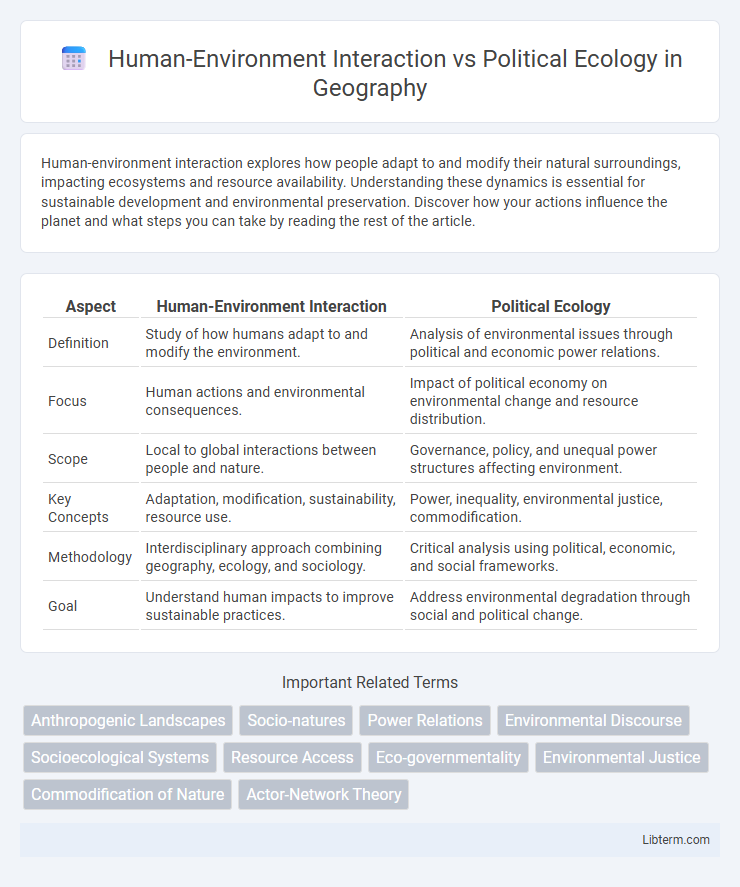Human-environment interaction explores how people adapt to and modify their natural surroundings, impacting ecosystems and resource availability. Understanding these dynamics is essential for sustainable development and environmental preservation. Discover how your actions influence the planet and what steps you can take by reading the rest of the article.
Table of Comparison
| Aspect | Human-Environment Interaction | Political Ecology |
|---|---|---|
| Definition | Study of how humans adapt to and modify the environment. | Analysis of environmental issues through political and economic power relations. |
| Focus | Human actions and environmental consequences. | Impact of political economy on environmental change and resource distribution. |
| Scope | Local to global interactions between people and nature. | Governance, policy, and unequal power structures affecting environment. |
| Key Concepts | Adaptation, modification, sustainability, resource use. | Power, inequality, environmental justice, commodification. |
| Methodology | Interdisciplinary approach combining geography, ecology, and sociology. | Critical analysis using political, economic, and social frameworks. |
| Goal | Understand human impacts to improve sustainable practices. | Address environmental degradation through social and political change. |
Introduction to Human-Environment Interaction
Human-Environment Interaction examines how human activities shape and are shaped by natural environments, emphasizing dynamic relationships and adaptive strategies. This approach analyzes land use, resource management, and cultural practices to understand environmental impacts and feedback loops. Political Ecology adds layers of power, economic forces, and social inequalities, but the foundation lies in the interdisciplinary study of ecological and human processes fundamental to Human-Environment Interaction.
Defining Political Ecology
Political ecology examines the complex relationships between political, economic, and social factors with environmental issues and changes, emphasizing power dynamics and resource control. Unlike human-environment interaction, which broadly explores how humans adapt to and modify their surroundings, political ecology explicitly critiques the role of governance, policy, and inequality in shaping environmental outcomes. This field highlights how environmental problems are often rooted in political and economic structures rather than just natural or human factors.
Historical Development of Both Concepts
Human-Environment Interaction emerged from geography and anthropology in the mid-20th century, emphasizing the reciprocal relationships between humans and their environments through cultural, economic, and technological adaptations. Political Ecology developed later in the 1970s as a critical framework, integrating political economy and environmental history to analyze how power dynamics, resource control, and social inequalities influence environmental issues and management. Both concepts evolved to address environmental challenges but diverged as Human-Environment Interaction focused on adaptive processes while Political Ecology scrutinized systemic socio-political factors shaping environmental outcomes.
Key Differences Between Human-Environment Interaction and Political Ecology
Human-Environment Interaction examines the reciprocal relationship between humans and their environment, emphasizing how human activities impact natural systems and how environmental changes shape human behavior. Political Ecology, by contrast, integrates political, economic, and social factors to analyze environmental issues within power dynamics and resource conflicts. Key differences include the scope of analysis, with Human-Environment Interaction focusing on ecological processes and behaviors, while Political Ecology critically addresses the role of inequality, governance, and institutional influences in environmental outcomes.
Approaches to Studying Human-Environment Relationships
Human-Environment Interaction emphasizes direct interactions and reciprocal influences between humans and their physical surroundings, focusing on spatial and ecological processes. Political Ecology investigates power dynamics, social inequalities, and economic systems that shape environmental outcomes and human experiences. These approaches differ as the former centers on environmental impacts and adaptation, while the latter critiques underlying political and socio-economic structures influencing environmental change.
Power, Politics, and Environmental Change
Human-Environment Interaction explores how human activities impact environmental processes, emphasizing reciprocal influences between societies and ecosystems. Political Ecology centers on power dynamics and political economic structures shaping environmental change, highlighting inequalities affecting resource access and control. The intersection reveals that environmental conflicts and degradation often arise from struggles over power, governance, and socio-political contexts.
Methodologies in Human-Environment Interaction Studies
Human-Environment Interaction studies prioritize quantitative methodologies such as spatial analysis, remote sensing, and ecological modeling to assess the reciprocal relationships between humans and their environments. These techniques enable precise measurement of environmental changes and human impacts over time and space, facilitating data-driven policy recommendations. Contrarily, Political Ecology employs qualitative methods including ethnography, participatory research, and critical discourse analysis to explore power dynamics, socioeconomic factors, and environmental justice issues influencing human-environment relationships.
Critiques of Political Ecology
Political ecology critiques human-environment interaction frameworks for oversimplifying complex power dynamics and neglecting socio-political contexts influencing environmental issues. It emphasizes the role of inequality, capitalism, and state power in shaping environmental degradation and resource access, challenging apolitical or technocratic approaches. Political ecology calls for integrating critical social theories to address structural causes behind ecological problems rather than merely examining human impact on nature.
Case Studies Comparing Both Approaches
Human-Environment Interaction studies emphasize how human activities impact natural systems, often using quantitative data from case studies like deforestation in the Amazon or urbanization in China to assess environmental changes and resource management. Political Ecology integrates social, economic, and political factors, as seen in case studies of water conflicts in the Nile Basin or mining in Bolivia, highlighting power dynamics and inequalities shaping environmental outcomes. Comparing both approaches reveals that Human-Environment Interaction provides ecological insights while Political Ecology offers a critical analysis of the socio-political contexts influencing environmental practices and policies.
Implications for Future Environmental Research
Human-Environment Interaction explores dynamic feedbacks between societies and natural systems, emphasizing resource use and adaptation, while Political Ecology critically examines power relations and socio-political structures influencing environmental outcomes. Future environmental research must integrate these approaches to address ecological challenges holistically, recognizing both biophysical processes and socio-political contexts. Combining spatial data analysis with ethnographic methods enables more nuanced insights into environmental justice and sustainable resource management strategies.
Human-Environment Interaction Infographic

 libterm.com
libterm.com